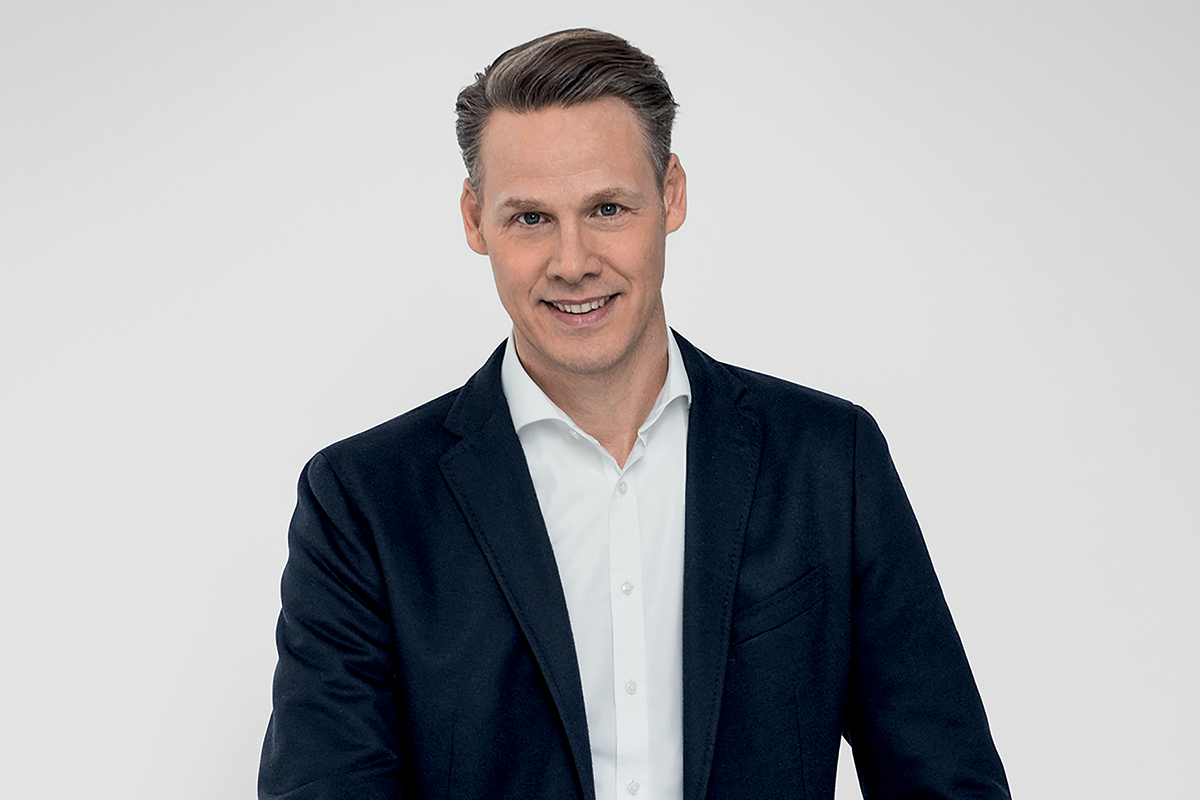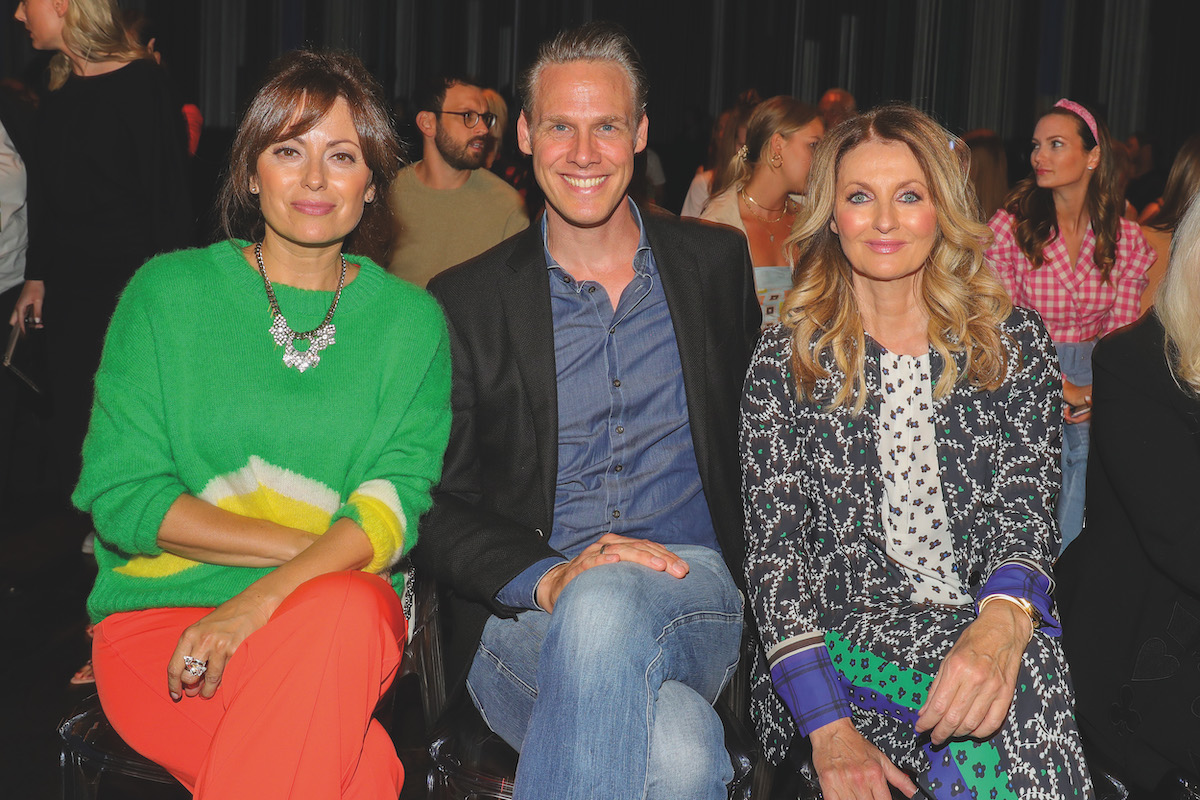A slim fit: Urs Konstantin Rouette
As Managing Director of Technical Development, Production, Purchase and Logistics, it’s all about increasing productivity for Urs Konstantin Rouette to ensure Marc Cain continues to turn heads in the premium ladies’ fashion category.
When you work for a privately held company, it helps if you like the boss. "It was a match," says Urs Konstantin Rouette, as he recalls the first time he met Helmut Schlotterer, the Founder and Chair of the Board of fashion label Marc Cain. "He is very impressive and open-minded, especially when it comes to technology and innovation."

Konstantin, as he is more commonly referred to, has fashion in his blood; the seventh generation in a long line of fabric dyers.
After unfavourable economic conditions forced the family to close down its dyeing and finishing mill in the late 1970s, his father Hans-Karl transferred his expertise into the classroom, becoming a highly regarded textile professor and author on the subject.
Konstantin himself studied textile engineering at Hochschule Niederrhein University of Applied Sciences, before making a foray into the world of sports apparel and men’s clothing.
When a headhunter called to discuss a move to Marc Cain in 2017, Konstantin jumped at the chance. "Mr Schlotterer wanted to start a generation change in the company," explains Konstantin – a self-described "young, but not so young 48-year-old."
He took on responsibility for the brand’s technical development and supply chain and was later joined by a new Managing Director of Finance, HR and IT as well as a Managing Director of Sales, Marketing and Design. "There is now a younger management with new ideas, jointly creating new workflows and making the brand fit for the future," he says.
The latter, he continues, involves a delicate balancing act: to uphold its position as the leader in premium ladies’ fashion during this period of adjustment.

"Change management in a successful company can be a challenge," he acknowledges, adding that only last year, top German industry publication TextilWirtschaft awarded Marc Cain the category leader in premium womenswear, including the number one position for quality, workmanship and fit.
"Besides the strong collection and look, this is what we’ve built the company on," he explains. "And, with all the modifications we are making, our major goal is to maintain our number one position."
As the saying goes, ‘If it ain’t broke, don’t fix it’, and Konstantin admits that convincing a team already at the pinnacle of its industry to undertake a journey of transformation was no easy task.
Yet, as he cautions, "Today, more than ever, every brand needs to be awake. Blink and chances are you will miss important trends in technology, for instance. You could also find yourself in trouble with rising costs because we are in an industry that is under tremendous competitive pressure," he adds.
"An example of this is the current trend in using 3D visualisation for developing collections, which Marc Cain has been investing in and working with for three years."
Sneak preview
Since the very beginning, Marc Cain has stood for high-quality knitwear creations, which are produced with great passion and spirit of innovation in the company’s own knitting factory in Bodelshausen. "Thanks to the high degree of expert competence, creativity and technical skill onsite, the team succeeds in enthusing the Marc Cain customer anew every season with extraordinary new knitwear," Konstantin explains.
"The knitwear highlights of Spring/Summer 2020 include a striking statement pullover and fluffy jacket made of jacquard knit, which unites the two brand traits characteristic of our DNA – innovative knitwear and animal prints." Its competitors, he adds, would struggle to launch similar articles.
Costs, he says, are "increasing more or less by themselves", and have been a primary focus since his first day at the company’s Bodelshausen headquarters.
"Germany is a high wage country and we have an in-house production team of 240 in a three-shift system," he explains. "Our garments have to be top-notch in terms of quality, of course, but they also need to be competitive in price, and this is something important we have been working on."
"Our garments have to be top-notch in terms of quality, of course, but they also need to be competitive in price, and this is something important we have been working on."
What he is most proud of in his role to date reflects what has been achieved in this regard. "My team and I have been able to increase productivity in our in-house production through slimming down processes without sacrificing quality and workmanship. This is not an easy task especially when you consider that we are already very efficient, in typical German style."
Another achievement is the reduction in reclamation rate and being even more strict with the end control. "When you are number one in quality, workmanship and fitting, it’s difficult to improve significantly, but, of course, in terms of costs, this has a strong impact."
Konstantin has found that, while quality has always been a priority at Marc Cain, examining the bottom line hasn’t. "We have this saying in Germany: to look under each stone; to check for hidden costs. As every head of every team has started to search such hidden costs, it has transformed the company," he explains.
"We’re saving money in good times for bad times that hopefully will never come, but until now, this hasn’t been part of the culture," he continues.
"We’re saving money in good times for bad times that hopefully will never come, but until now, this hasn’t been part of the culture."
These measures are all being undertaken to safeguard one critical aspect of the business. "We are the only premium ladies’ fashion brand in Germany with an in-house production facility. It’s part of the DNA of the brand. That’s why saving costs and increasing productivity are so important."
And, while the brand’s designers are experts in using each collection to tell a story (the colours, animals and prints of Namibia are the inspiration for its Spring/Summer 2020 range, for example), as the head of department, Konstantin is more than aware that the wellbeing and safety of the brand story starts and stops with its in-house production.
This cost-cutting doesn’t mean spending has stopped, however. "Of course, we invest where necessary," he says. This includes the construction of a logistics complex and automated warehouse, at a cost of €35 million in 2015.
But, if there’s one area where funding flows as much today as when the label was founded in 1973, it’s towards research and development and headlining innovations such as its Knit & Wear 100% Made in Germany Collection.
Using state-of-the-art 3D knitting techniques, wardrobe staples such as pullovers, knitted jackets and skirts are produced in one single take and without seams. A label, sewed into each garment, reinforces the ‘100% Made in Germany’ message.
More than ever, the country’s reputation for trusted, high-quality workmanship is one to be emphasised. His region, in particular, is no stranger to corporate success, with Porsche, Mercedes-Benz, Fisher, and Bosch just some of the names that call the state of Baden-Württemberg home.
"The local mentality here in Swabia is to puzzle over something until it works, which is the reason why there are so many thriving companies here across all kinds of industries."
At Marc Cain, this way of thinking that means that the philosophy is to insource rather than outsource where possible. "That’s why we have our own production facility," he explains.
On trend
Sustainability is another subject close to Konstantin’s heart. "In my previous roles, I pushed for sustainable production, and I feel that our competition in the premium category has yet to start the conversation," he explains. His philosophy is that premium quality, as one of Marc Cain’s key competencies, can only be generated in safe, well-run and clean production facilities accompanied by long-term supplier relationships. The company requires social audits from all its production partners, "no matter where they are located".
"The trend in fashion is moving towards sustainable materials," Konstantin continues. While its 100% Made in Germany Collection is "to some extent already sustainable since it doesn’t leave the country, produce wastage in material, or get transported to any confection company because it is 3D knitted," the transformation is manifesting itself in other ways. "Our Spring/Summer Collection, for example, contains items made from yarns of recycled polyamide and we have used denim fabric from Candiani, an Italian denim weaver, who reduces water, energy and chemical use through innovative production processes," he says. "Step by step, we will expand the sustainable materials in our collections."
"In certain cases, we have even manufactured our own machines because what we needed was simply not available in the textile machinery markets."
For Konstantin, who admits that it’s the first time he’s witnessed such self-reliance, the experience has been eye-opening. "It’s unique," he says, adding that the mentality has infiltrated other aspects of the company, from software development to retail interiors.
"We even have a dedicated workshop for carpenters to make our shop and office furniture. I don’t think there are many fashion brands like us," he laughs. It’s a statement with which it isn’t so hard to agree.
Proudly supported by: